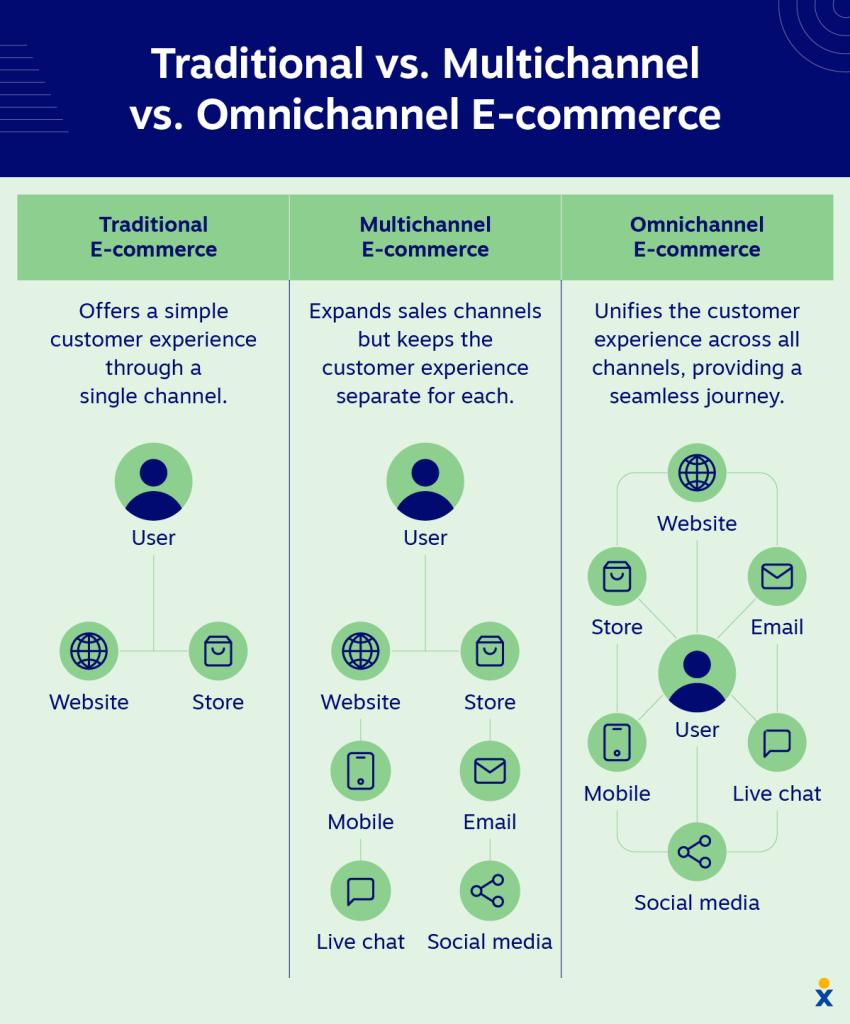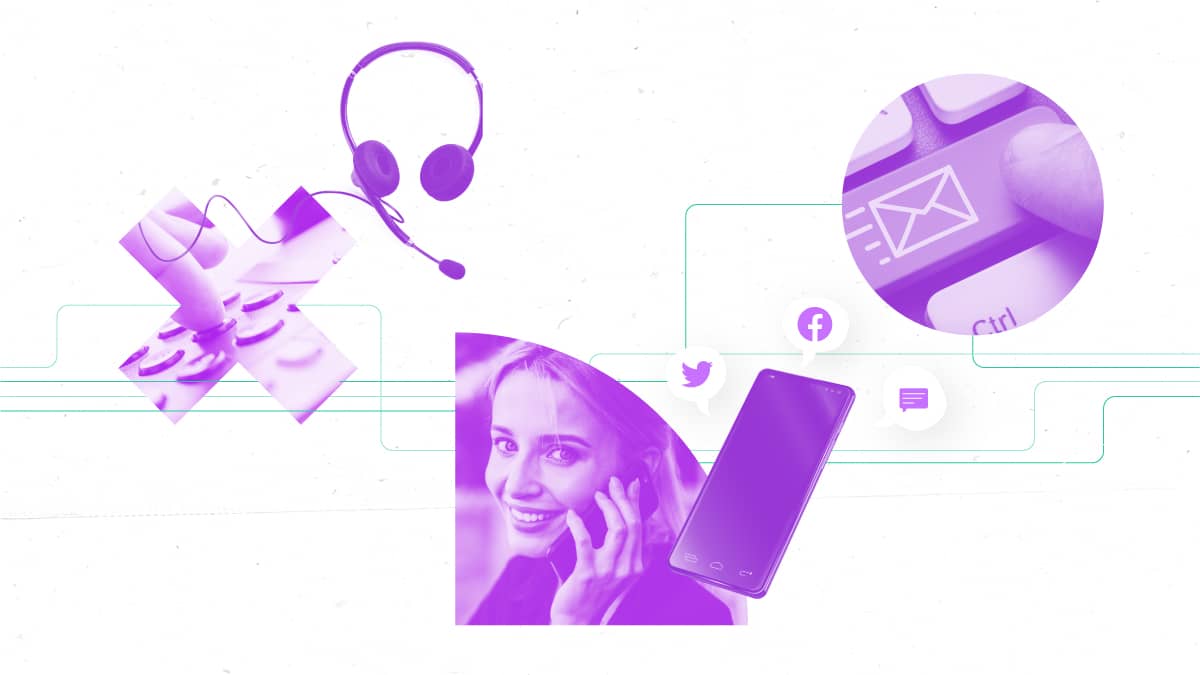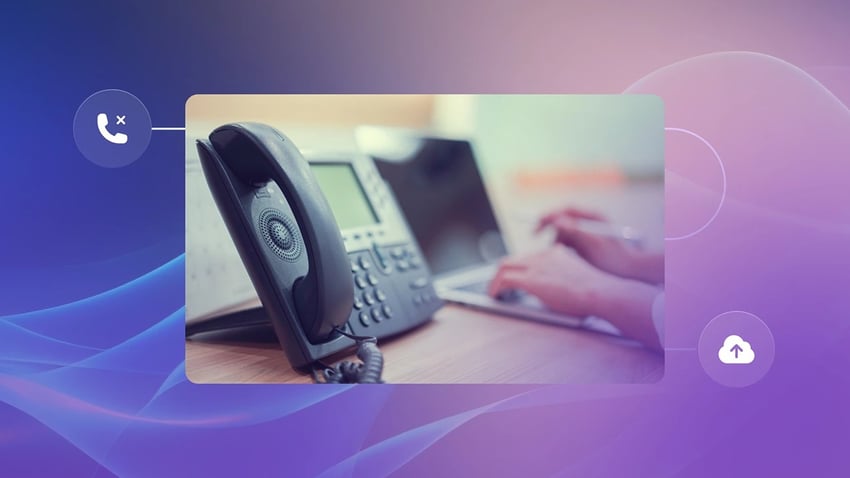From social media interactions to email inquiries, phone calls, and live chats, the avenues for customer communication are more varied and complex than ever before. Businesses must therefore strive to meet their customers where they are, rather than force the customer to come to just one place: the business’ website.
This evolution has led to the rise of the multichannel contact center — a central hub that handles all inbound and outbound customer service communications. To transform your customer service strategy and keep your customers happy, understanding the intricacies of a multichannel contact center is essential.
In this comprehensive guide, you’ll learn what a multichannel contact center is, its benefits, key features, and how it compares to the omnichannel contact center. Plus, we’ll share a few practical tips on setting one up for your business.
What Is a Multichannel Contact Center?
A multichannel contact center is a customer service hub that integrates and manages interactions across multiple communication channels, such as phone calls, live chat, social media, or any other digital channel, to provide a seamless and enhanced customer experience.

Multichannel contact center software is similar to traditional call center software, except it allows team members to help customers in multiple ways on their preferred channel. This contact center solution allows you to quickly connect with customers from one central platform, no matter how they choose to contact you, which helps improve business efficiency and customer satisfaction.

Typically deployed as a cloud contact center, multichannel routing directs customer interactions from various communication channels outside of a standard call center and custom call routing to the appropriate support or sales agent.
Unlike a multichannel call center, where you might label different “call channels” like sales or repairs, multichannel contact center software refers to separate communication channels. Customer interactions take place over:
- Voice phone calls
- Interactive voice response (IVR)
- Email messages
- Website chat
- Social media
- Text messaging (SMS)
Research from McKinsey shows that most customers engage with three to five different channels in order to resolve a request. So if you’re not responsive on those channels, are you sure you’re providing actual customer service? While voice (phone calls) remains the primary inbound support channel, you simply can’t ignore other popular methods like social media or SMS text messaging.
To provide the best customer experience, consider multichannel customer support when customers have a preferred channel outside of your current phone system setup.
Multichannel contact center example
Imagine a new customer calls in with a basic support question. The contact center software shows that the customer hasn’t attended a customer success webinar. Noticing that the email address provided doesn’t match the company’s records, the agent updates it and adds the caller to a new customer journey sequence.
This proactive approach highlights how customer care can go beyond reactive support. Even when people change email addresses and jobs, reaching out via phone to customers with outdated or non-functional email addresses ensures continuous engagement.
Multichannel contact centers provide an enhanced customer experience by seamlessly integrating various communication methods, allowing agents to provide proactive support rather than just answering questions in a basic, transactional manner.
Multichannel customer service example
A prime example of multichannel customer service is an e-commerce company that provides support through various channels, including phone, email, live chat, social media messaging, and self-service knowledge bases. This approach empowers people to choose their preferred method of contact, which makes for a better experience and thus boosts customer engagement.
For instance, shoppers can reach out via a 1-800 number for phone support, engage with a chatbot on the website for quick queries, ask public questions on the company’s social media feed, and participate in a community forum where customers assist each other. These diverse contact methods cater to individual preferences, offering flexibility and convenience in each interaction.
In order to provide a seamless experience, the company must integrate these channels on the back end so as to provide smooth transitions and consistent support across all platforms. This integration is crucial for providing a unified and efficient customer service experience.
Benefits of Multichannel Communications
Using a multichannel strategy ensures that your customers are seeing a consistent message across various platforms. This reinforces your brand image and builds trust among your audience.
A multichannel contact center offers many benefits for both businesses and their customers:
- Enhanced Customer Experience: Customers can interact with businesses through their preferred communication channels, whether it’s email, phone, live chat, social media, or SMS. Seamless transitions between channels create a more satisfying and personalized customer journey.
- Increased Customer Engagement: Businesses can reach customers on the platforms they use most, leading to higher engagement and better response rates.
- Improved Efficiency: Agents can manage multiple channels from a single interface, streamlining workflow and reducing response times. Plus, automated routing and CRM integration with customer information make sure that queries are directed to the right department or agent.

- Better Data and Insights: Multichannel contact center solutions aggregate data from various sources, providing comprehensive insights into customer behavior and preferences. Businesses can analyze this data to improve their strategies and tailor their services to better meet customer needs.
- Flexibility and Scalability: Companies can easily add or remove communication channels based on demand or changing customer preferences, making it easy to scale the business.
- Competitive Advantage: Offering a multichannel communication approach sets a business apart from competitors who may still rely on single or limited channels. It demonstrates a commitment to meeting customers’ needs and staying current with technological advancements.
Evaluating contact centers? Get the buyer’s guide.
This guide reveals the five pillars of a modern platform, key questions to ask, and red flags to avoid.
Drawbacks of multiple communication channels
While multichannel contact center software offers a lot of convenience, it has a few limitations.
Complexity in management
Managing multiple communication channels in a contact center can be complex. Each channel may require different processes, tools, and protocols, leading to an inefficient system. Agents must juggle various platforms, which can result in inconsistent service quality and the potential for more errors.
The complexity can also make it difficult for supervisors to oversee operations and maintain high standards across all channels, ultimately impacting the overall customer experience.
Higher operational costs
Operating a multichannel contact center can have significant expenses. The need for advanced technology to integrate and manage multiple communication platforms can drive up costs.
Also, hiring extra staff and training agents, old and new to handle different channels and maintain a consistent quality of service requires additional investment. Smaller businesses, in particular, may find these costs prohibitive, limiting their ability to implement a comprehensive multichannel strategy and compete with larger enterprises.
Fragmented customer journey
Poor integration in a multichannel contact center can result in siloed channels, where information is not shared between different communication methods. This fragmentation means agents often lack a complete view of customer interactions across all channels, leading to repetitive information gathering. And when customers have to explain their issues multiple times as they switch between each communication channel, they become very frustrated with the business.
This inconsistency not only affects the customer but also leads to wasted resources within the contact center.
Features of a Multichannel Contact Center Platform
Here are seven must-have features to look for when choosing multichannel contact center software:
- Agent Multichannel Dashboard. A unified interface where agents can manage all communication channels, such as voice, email, SMS, live chat, and social media, from a single dashboard.
- Multichannel Routing and IVR. Intelligent routing systems, including Interactive Voice Response (IVR), to direct customer inquiries to the most appropriate agent based on skills and availability.
- Call Queueing and Auto Dialer. Tools to manage call queues efficiently and automate outbound calls, enhancing agent productivity and customer satisfaction.
- AI Support and Automations. AI-driven features like chatbots, automated responses, and workforce management tools to streamline operations and provide quick resolutions.
- Third-party App Integrations. Integration with Customer Relationship Management (CRM) systems and other third-party applications to provide agents with comprehensive customer data and streamline workflows.
- Self-Service Tools. Features like automated chatbots and IVR systems that allow customers to resolve issues on their own if they choose, reducing the load on human agents.
- Analytics and Monitoring. Real-time and historical analytics to monitor performance, customer sentiment, and key performance indicators (KPIs). This includes features like live queue monitoring, call transcriptions, and custom reporting.

Multichannel contact center pricing
The beauty of multichannel contact center pricing is that you only need to pay for what you’re going to use. This pricing model is standard since most multichannel deployments are delivered via the cloud.
For example, if you need voice, email, and web chat, these are the only channels you’ll pay for. You’re buying into a subscription model – in this case, Contact Center as a Service (CCaaS). Or you can opt for all channels if you wish. You can turn on all incoming channels for contact centers wanting to support customers through every possible means.
Depending on features, integrations, and implementation needs, multichannel contact center software costs start at $75 per user per month.
How Do You Set Up a Multichannel Contact Center?
Here are the four basic steps on how to set up a multichannel contact center.
Assess your needs
Conduct customer interviews or send out a survey to find out the preferred channels of communication to reach you, such as phone, email, live chat, social media, and SMS. Determine the volume of interactions and the types of inquiries typically received across these channels.

For example, when a customer needs help troubleshooting their cell phone, they don’t always need to speak verbally with an advisor. Instead, you can route web chat inquiries through to members of your multi channel call center or specialists in that area. And they can serve three, four, or even five customers at once!
This both satisfies the customer requirements and reduces call volumes.
Choose the right software
Select a contact center platform that integrates with the communication channels you’ve identified, such as voice, email, chat, social media, etc. Make sure the software provides a unified interface for agents to manage all channels, as well as features like CRM integration, analytics, and real-time monitoring.
When evaluating options, consider multichannel contact center providers that offer comprehensive solutions, including implementation support and ongoing maintenance, to make sure your contact center operates smoothly and efficiently.
Train your agents
Provide comprehensive training for your agents about using the integrated platform and managing customer inquiries efficiently. This may include training on AI and cloud management, CRM and knowledge base usage, and effective communication across different channels.
For example, phone and chat will need personnel and call routing programs, while self-service requires an online help desk.
Where does your CX strategy stand with AI?
Take the AI Maturity assessment to get personalized recommendations on how to enhance your CX.
Establish standard operating procedures
You’ll need to develop SOPs to manage customer interactions across all channels and ensure consistent service quality. These SOPs should include clear guidelines for escalating issues, routing inquiries, and maintaining data privacy and security.
Additionally, establish integrated workflows and customer data management practices across all channels to provide a consistent customer experience. Finally, monitor contact center metrics such as service quality, channel usage, queue times, and resolution rates to make sure you’re continually improving your multi-channel contact center.

What Is the Difference Between an Omnichannel Contact Center and a Multichannel Contact Center?
There are subtle differences between a multichannel and omnichannel contact center, but collectively, they leave call centers in the past.
The main difference comes down to the automation between channels. This capability makes channel support autonomous and easy for both the customer and your agents.
An omnichannel contact center is a multichannel contact center that allows you to support customers across different channels at the same time. So, if your customer begins a request from an online chat and then calls to get an update, agents have access to that same information and can continue the conversation.

The other distinction is pricing.
Generally, user seats are about the same price, depending on the number of channels. However, omnichannel functionality tends to cost more for onboarding and access to advanced cross-channel integrations. Omnichannel licenses come in at around $75/month per user, depending on your specific features and business applications.
Of course, the best way to get an accurate price is to talk to an expert to get a custom quote for your needs.
When evaluating omnichannel vs. multichannel, focusing on how your customers operate is essential. If there are multiple touchpoints in the customer’s journey, you should think about omnichannel.
The table below highlights the features and functionality of a call center, multichannel, and omnichannel contact center.
| Functionality | Call Center | Multichannel | Omnichannel |
|---|---|---|---|
| Inbound calls | ✅ | ✅ | ✅ |
| Outbound calls | ✅ | ✅ | ✅ |
| Call queuing | ✅ | ✅ | ✅ |
| Automatic callbacks | ✅ | ✅ | ✅ |
| Customer engagement reporting | ✅ | ✅ | ✅ |
| APIs for custom integration | ✅ | ✅ | ✅ |
| Customer satisfaction tools | ✅ | ✅ | ✅ |
| CRM integration | ✅ | ✅ | ✅ |
| Self-service menus | ✅ | ✅ | ✅ |
| Real-time analytics | ✅ | ✅ | ✅ |
| Healthcare-ready (HIPAA Compliant) | Varies | ✅ | ✅ |
| ❌ | ✅ | ✅ | |
| Web chat | ❌ | ✅ | ✅ |
| SMS | ❌ | ✅ | ✅ |
| ❌ | ✅ | ✅ | |
| ❌ | ✅ | ✅ | |
| ❌ | ✅ | ✅ | |
| Seamlessly switch communication channels | ❌ | ❌ | ✅ |
| One team can handle requests on all channels | ❌ | ❌ | ✅ |
Nextiva’s Multichannel Contact Center Solution
It’s best to keep it simple when you explore a new multichannel or omnichannel solution. Then, as your business grows, it’s easy to connect channels to your customer service team.
With Nextiva’s contact center solution, you can replace over a dozen apps with one enterprise-grade customer communication platform. Exceed customer needs with a feature-rich cloud contact center and track your progress with unified reporting across every channel.
With Nextiva Contact Center, you can:
- Manage all the inbound and outbound channels easily
- Integrate your phone system and contact center
- Leverage workforce automation to scale
- Roll out 24/7 customer support options
- Access the latest features without any interruptions
Help your agents reach their full potential with the Nextiva Contact Center.
Upgrade your contact center.
See why thousands of businesses made the switch to Nextiva’s contact system solution.

















 Business Communication
Business Communication 












